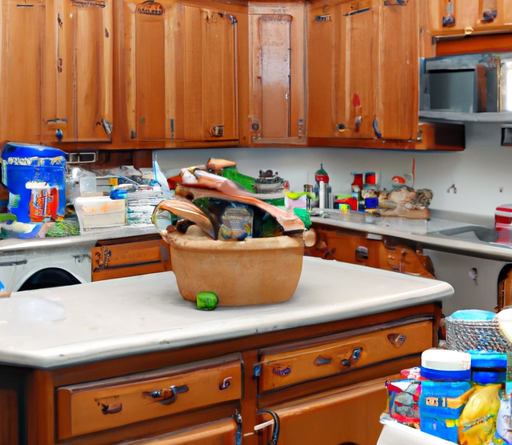In this article, we will explore the best practices for safely storing and organizing knives in the kitchen. We understand that keeping your knives in a secure and accessible manner is not only important for functionality but also for the safety of everyone in your household. Whether you are a seasoned chef or simply a cooking enthusiast, finding the right storage solution for your knives is crucial to maintaining their sharpness and preventing accidents. So, join us as we take a closer look at some practical tips and ideas to help you create a safe and efficient storage system for your kitchen knives.

Choosing the Right Knife Storage Option
When it comes to safely storing and organizing knives in the kitchen, there are several factors to consider. First and foremost, you need to evaluate your kitchen layout and available space. This will help determine the type of knife storage option that would work best for you. Additionally, it’s essential to take into account the number and types of knives you own, as this will influence your storage needs.
Knife Storage Options
There are several knife storage options available, each with its own set of advantages and considerations. Let’s take a closer look at some of the most common options:
Knife block
A knife block is a classic and popular choice for storing knives. It typically consists of a wooden block with slots that hold the blades securely. One of the significant advantages of a knife block is that it keeps your knives easily accessible on your kitchen countertop. Additionally, it helps protect the blades from damage and keeps them organized in one place.
Magnetic knife strip
A magnetic knife strip is another excellent option for knife storage. It is a magnetic bar that you can attach to the wall or a cabinet, allowing you to hang your knives vertically. This option not only saves countertop space but also adds a modern and sleek touch to your kitchen. However, it’s crucial to ensure that the magnet is strong enough to hold your knives securely and that it is installed properly to prevent accidents.
In-drawer knife tray
If you prefer to keep your knives hidden away, an in-drawer knife tray might be the solution for you. This type of storage option fits directly into your kitchen drawer, providing a designated space for your knives. It helps keep your countertops clear and avoids potential accidents. However, make sure to choose a tray specifically designed for knives to ensure they are adequately protected and separated.
Knife roll or case
For those who frequently travel or need to transport their knives, a knife roll or case is an ideal storage option. These rolls or cases typically feature individual slots for each knife, ensuring they remain protected and secure during transportation. Moreover, they offer the benefit of easy portability, allowing you to bring your knives along wherever you go.
Best Practices for Knife Storage
Now that we’ve explored the different knife storage options, let’s discuss some best practices to ensure the safety and longevity of your knives:
Keep knives easily accessible
Regardless of the storage option you choose, it’s crucial to keep your knives easily accessible. This not only saves you time in the kitchen but also minimizes the chances of accidents occurring when searching for a specific knife.
Avoid storing knives loose in drawers
Storing knives loose in drawers is not recommended as it can lead to injuries and damage to the blades. Without proper storage and protection, the blades can become dull or chip, posing a risk when handling them.
Protect the blades from damage
To maintain the sharpness and integrity of your knives, it’s essential to protect the blades from damage. Whether you opt for a knife block, magnetic strip, or another storage option, ensure that the blades are securely held to prevent them from banging against other utensils or surfaces.
Separate knives to prevent contact
Different types of knives serve various purposes, and their blades have different shapes and sizes. By separating knives and preventing them from coming into contact with one another, you reduce the risk of blades becoming damaged or dull. In addition, it promotes a more organized storage system, making it easier to find the knife you need.
Clean and dry knives before storage
Before placing your knives in storage, it’s essential to clean them thoroughly and ensure they are completely dry. This helps prevent the buildup of bacteria and avoids any potential corrosion or rusting. Remember to exercise caution while cleaning and drying the knives to avoid accidental cuts.
Do not store knives in a dishwasher
It is important to note that knives should never be stored in a dishwasher. The high heat, moisture, and movement in a dishwasher can damage the blades and compromise their quality. Always hand wash and dry your knives carefully to maintain their longevity.
Proper Knife Organization
To optimize your knife storage and make it more efficient, it’s helpful to consider proper organization techniques. Here are some tips for effectively organizing your knives:
Categorize knives by size and purpose
Sorting your knives by size and purpose can make them easier to locate when you need them. Categorizing them into groups such as chef’s knives, paring knives, serrated knives, and specialty knives allows for quick identification.
Use dividers or compartments
Using dividers or compartments within your chosen storage option can further enhance organization. This prevents the knives from rubbing against each other and keeps them neatly separated. For knife blocks or drawers, you can often find inserts specifically designed for this purpose.
Consider displaying knives for easy identification
If you have a collection of visually appealing and high-quality knives, consider displaying them. A knife display can serve as both a functional and decorative element in your kitchen, allowing you to showcase your knives while keeping them easily accessible.

Knife Safety Measures
When it comes to knives, safety should always be a top priority. Here are some essential knife safety measures to follow:
Always handle knives with care
Whether you are storing, retrieving, or using knives, it’s crucial to handle them with care. Always hold them by the handle and avoid touching the blade. This reduces the risk of accidental cuts and ensures your safety.
Store knives out of reach of children
If you have young children in your home, it’s important to store your knives out of their reach. Consider higher storage options or lockable cabinets to prevent any accidents that may occur as a result of curiosity or mishandling.
Use knife guards or sheaths
To provide an extra layer of protection for your knives, consider using knife guards or sheaths. These covers fit over the blades, preventing accidental cuts and reducing the risk of damage or dulling when stored or transported.
Sharpen knives regularly
Keeping your knives sharp is not only important for their functionality but also for safety. Dull knives can slip and cause accidents. Regularly sharpening your knives ensures that they are efficient and reduces the chances of accidents occurring.
Maintenance and Cleaning Tips
Proper maintenance and cleaning are essential for preserving the longevity and performance of your knives. Here are some tips to help you with this:
Hand wash knives
To avoid damaging the blades and handles, it’s generally best to hand wash your knives. Use mild dish soap and warm water, gently scrubbing the blades with a sponge or brush. Make sure to dry them thoroughly afterward to prevent any moisture-related issues.
Dry knives thoroughly
After washing your knives, ensure they are completely dry before storing them. Moisture can lead to corrosion and rust, which can compromise the sharpness and overall quality of the blades. Wipe the knives with a clean towel or air dry them to eliminate any remaining moisture.
Avoid cutting on hard surfaces
Using your knives on hard surfaces, such as stone or glass cutting boards or countertops, can dull the blades. Instead, opt for cutting boards made of wood, bamboo, or plastic materials, as they are more forgiving and less likely to damage the sharpness of your knives.
Use cutting boards appropriate for the material of the knife
Certain types of knives are better suited for specific cutting boards. For example, avoid using ceramic knives on hard cutting surfaces, as they can chip or break. Match the cutting board material to the type of knife to maintain both the board and the knife’s quality.

Additional Considerations
Here are a few additional considerations to keep in mind when storing and organizing your knives:
Label or mark knives for easy identification
To simplify the process of finding a specific knife quickly, consider labeling or marking them. This can be as simple as attaching a label or sticker to the handle or blade, indicating the knife’s purpose or name.
Consider investing in a knife sharpener
While regular sharpening is important, investing in a knife sharpener can be a valuable addition to your kitchen arsenal. A knife sharpener allows you to maintain the edges of your knives easily and effectively, ensuring they are always ready for use.
Regularly inspect knife storage for any issues
Take the time to regularly inspect your knife storage for any signs of wear, damage, or malfunction. This includes checking the integrity of knife blocks, magnetic strips, in-drawer trays, or knife rolls. Address any issues promptly to maintain a safe and organized storage system.
By considering your kitchen layout, evaluating different knife storage options, and taking into account the number and types of knives you own, you can choose the right storage method for your needs. Following best practices for knife storage, organizing your knives properly, and implementing safety measures will help ensure the longevity of your knives and the safety of everyone in your household. Remember to maintain and clean your knives regularly, use appropriate cutting surfaces, and consider additional factors such as knife labeling and investing in a knife sharpener. With proper care and organization, your knives will be ready to assist you in all your culinary adventures.









